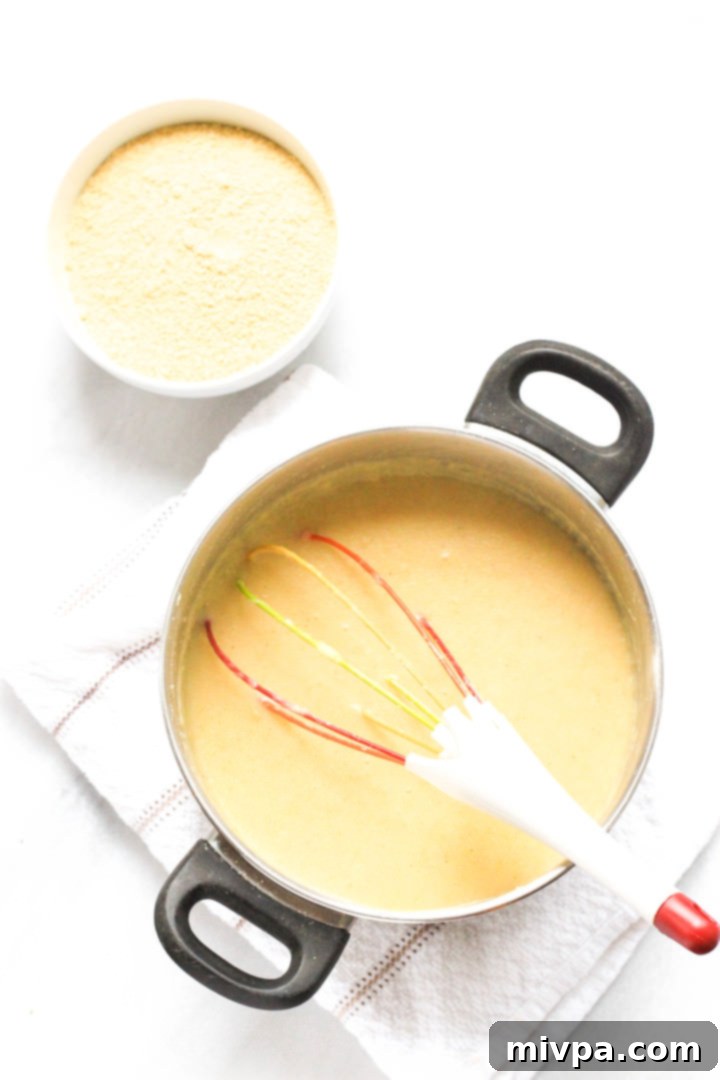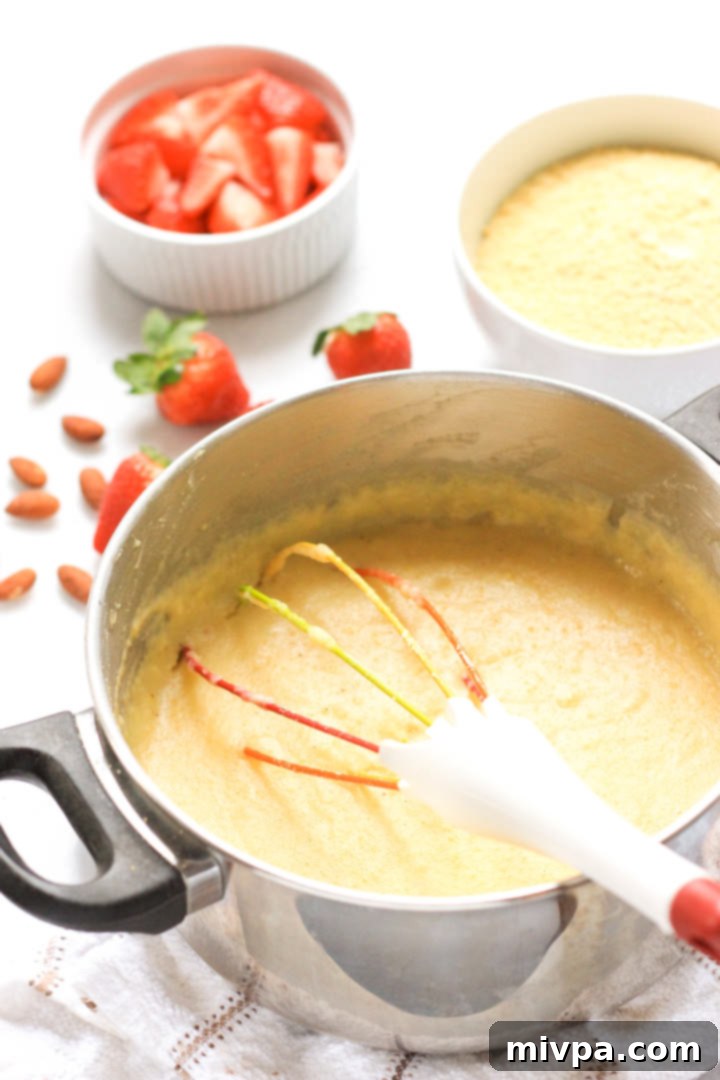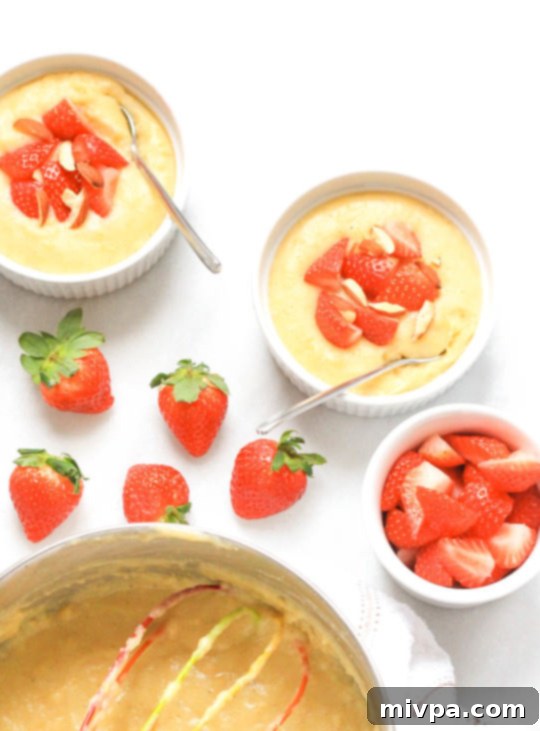Creamy Vegan & Gluten-Free Breakfast Polenta with Fresh Berries & Almonds
Creamy, wonderfully rich, and perfectly thick, this delightful breakfast polenta is more than just a meal – it’s a comforting hug in a bowl, reminiscent of a warm, wholesome pudding. Imagine starting your day with a bowl of this golden goodness, topped with vibrant fresh berries and crunchy almonds, providing a delicious burst of energy in less than half an hour. Best of all, this incredible polenta porridge is entirely gluten-free, completely dairy-free, and proudly vegan, making it an accessible and satisfying breakfast option for everyone.

Cold mornings call for warm, comforting meals that nourish the soul and fuel the body. While sweet potato toasts and light omelets have their place, nothing quite beats a hearty bowl of warm porridge to chase away the chill. This creamy breakfast polenta fits the bill perfectly, offering a delightful twist on traditional breakfast cereals. It’s incredibly easy to prepare, bursting with flavor, and caters to a variety of dietary needs, ensuring a happy start to any day.
[feast_advanced_jump_to]
Cozy Comforting Breakfasts for Colder Months:
As the temperatures drop and winter officially settles in, my cravings for warm, soul-satisfying breakfasts intensify. There’s something inherently comforting about a steaming bowl of porridge on a chilly morning, providing both warmth and sustained energy. If you’re looking for more delicious and healthy ways to start your day during the colder months, here are a few of our other favorite porridge recipes, all designed to keep you cozy and well-fed:
- Easy Buckwheat Porridge (Gluten-Free, Vegan): A nutty and wholesome alternative.
- Creamy Millet Porridge (Gluten-Free, Vegan): Light, fluffy, and incredibly versatile.
- 5-Minute Quinoa Porridge (Gluten-Free, Vegan): Perfect for busy mornings when time is of the essence.
- Blueberry and Almond Flaxseed Porridge (Gluten-Free, Dairy-Free): Packed with antioxidants and healthy fats.
What is Polenta? A Northern Italian Staple Transformed for Breakfast
For those unfamiliar with polenta, it is essentially a porridge crafted from cornmeal, deeply rooted in the culinary traditions of Northern Italy. Historically, polenta gained popularity among farmers as a humble yet hearty and economical meal. Over centuries, it transcended its origins to become a celebrated staple found on menus in Italian restaurants worldwide, appreciated for its versatile texture and comforting appeal.
While traditionally a savory dish, often served warm with rich, slow-cooked tomato-based sauces like ragu or marinara, or even “white” sauces featuring sausages, polenta’s adaptability knows no bounds. In Italian American households, it’s a familiar sight at the dinner table, a testament to its enduring legacy. However, its potential extends far beyond savory applications. Though not as commonly served sweet for breakfast, polenta truly shines when sweetened, transforming into an incredibly satisfying and warm breakfast option, especially comforting during the colder months.
The beauty of polenta lies in its simple ingredients and the creamy texture it develops when cooked slowly. It’s a truly versatile food that can be prepared in various ways, from soft and creamy to firm and grilled. Today, we’re embracing its sweeter side, focusing on creating a truly creamy breakfast polenta porridge that’s absolutely perfect for waking up on a crisp winter morning – or any morning, for that matter! Its subtle corn flavor provides a wonderful base for sweet toppings, making it a delightful alternative to oatmeal or other grain porridges.
Why This Creamy Breakfast Polenta Recipe Will Become Your New Favorite:
There are countless reasons to fall in love with this breakfast polenta recipe. It’s not just a meal; it’s an experience that brings warmth, satisfaction, and ease to your morning routine. Here’s why this recipe stands out:
- Simple & Accessible Ingredients: You won’t need to hunt for exotic items for this recipe. The main ingredients required for this homemade polenta are incredibly basic and easily accessible at any local grocery store. Chances are, you might even have most, if not all, of them on hand in your pantry and refrigerator right now! This means less planning and more time enjoying your delicious breakfast.
- Incredibly Easy to Make: Don’t let the idea of cooking polenta intimidate you. This breakfast polenta comes together with remarkable ease, making it a perfect recipe for beginners and seasoned cooks alike. With straightforward steps, anyone can whip up a batch of this creamy goodness without any culinary fuss. It’s quick enough for a weekday and special enough for a weekend brunch.
- Luxuriously Super Creamy Texture: The hallmark of a truly great polenta is its creamy consistency, and this recipe delivers in spades. With a comfortingly smooth and velvety texture, this creamy polenta porridge feels like a warm, tender hug on a cold winter’s morning. It’s rich without being heavy, providing a satisfying mouthfeel that will keep you coming back for more.
- 100% Gluten-Free, Dairy-Free, and Vegan: One of the absolute best features of this breakfast polenta is its inclusivity. It is completely gluten-free, entirely dairy-free, and proudly vegan. This means that individuals with Celiac disease, gluten sensitivities, lactose intolerance, or those simply following a plant-based diet can enjoy this hearty and flavorful breakfast without any concerns or compromises. It’s a breakfast for everyone to savor!

Essential Ingredients You’ll Need for Creamy Breakfast Polenta + Important Notes & Substitutions:
Crafting the perfect creamy breakfast polenta requires just a few basic ingredients, most of which you likely already have. Below is a detailed overview of what you’ll need, along with helpful notes and substitution options to customize this easy breakfast recipe to your taste and dietary preferences.
(For the precise measurements and quantities of each ingredient, please refer to the comprehensive recipe card located at the very bottom of this post.)
- Water: This is the base of our porridge. I highly recommend using filtered water for the purest taste, but readily available potable tap water will work perfectly fine if that’s what you have. For an even creamier, richer consistency, you can substitute a portion or all of the water with additional almond milk or another non-dairy milk.
- Almond Milk: I prefer using an unsweetened version of my 5-minute homemade almond milk for its clean flavor and control over sweetness. However, any unsweetened non-dairy milk will work beautifully. Great options include cashew milk (for extra creaminess), tigernut milk, rice milk, oat milk, or even light canned coconut milk for a tropical hint. If you are not adhering to a dairy-free diet, feel free to use regular whole milk for a traditional rich flavor.
- Polenta: The star of our show! It’s crucial to use actual polenta for the best texture. If polenta is unavailable, a suitable substitute would be coarsely-ground cornmeal, which shares a similar consistency and cooking profile. Avoid fine cornmeal as it can become pasty.
- Vegan Butter: To ensure this recipe remains delightfully vegan and dairy-free, I’ve opted for vegan butter. It adds a wonderful richness and depth of flavor. Alternatively, refined coconut oil is an excellent choice, as it has a more neutral flavor compared to extra virgin coconut oil, which can impart a distinct coconut taste. If dairy is not an issue for you, traditional butter works just as well.
- Sugar: I used cane sugar for its balanced sweetness. You can easily adjust the type and amount of sugar to your preference. Other great options include white sugar, light brown sugar (for a hint of molasses flavor), dark brown sugar, or coconut sugar (which offers a slightly caramel-like note). For those managing blood sugar levels or following a ketogenic diet, I highly recommend using Lakanto monkfruit sweetener. It’s a fantastic 1:1 sugar substitute that has a zero-glycemic index and will not significantly raise your blood sugar.
- Strawberries: Fresh strawberries add a beautiful sweetness and a touch of tartness, along with vibrant color. While I love fresh strawberries, this polenta is incredibly versatile! Feel free to top it with any other types of fresh berries you enjoy, such as juicy blueberries, tart blackberries, or sweet raspberries. You can even venture beyond berries and use other seasonal fruits like sliced kiwi, mango, or even peaches.
- Almonds: Sliced almonds provide a delightful crunch and added texture, complementing the creamy polenta beautifully. Don’t hesitate to experiment with other nuts if you prefer. Walnuts, pecans, peanuts, or even luxurious macadamia nuts would make excellent additions. For a nut-free option, toasted pumpkin or sunflower seeds work wonderfully.

How to Make Creamy Breakfast Polenta: A Simple Step-by-Step Guide
Creating this delightful breakfast polenta is surprisingly simple and requires minimal effort for maximum comfort. Follow these easy steps to achieve a perfectly creamy and delicious porridge every time:
1. Bring Liquids to a Boil
Begin by combining the measured water and almond milk (or your preferred milk alternative) in a sturdy medium-sized pot. Place the pot over medium-high heat and bring the mixture to a rolling boil. This initial step is crucial for ensuring the polenta cooks evenly and quickly.
2. Gradually Add Polenta and Whisk Consistently
Once the liquid reaches a vigorous boil, reduce the heat to medium. Now, slowly and gradually sift or sprinkle the polenta over the boiling liquid. As you add the polenta, immediately use a whisk to stir the mixture consistently and vigorously. This continuous whisking is incredibly important to prevent any lumps from forming, ensuring your polenta porridge is perfectly smooth and creamy. Keep whisking to incorporate all the cornmeal evenly.
3. Whisk Until Thickened to a Pudding-Like Consistency
Continue to whisk the polenta mixture constantly, making sure to scrape the bottom and sides of the pot to prevent sticking and burning. This process should take approximately 10 minutes. You’ll notice the mixture gradually thickening, transforming into a consistency similar to a watery, yet luxurious, pudding. The key is patience and continuous stirring to achieve that signature creamy texture.
4. Incorporate Vegan Butter for Added Richness
Once the polenta has thickened to your desired consistency, add the vegan butter (or coconut oil/regular butter). Continue to whisk the mixture diligently for approximately another 5 minutes, or until the vegan butter has completely melted and is fully combined and integrated with the rest of the creamy polenta. This step adds a wonderful richness and depth of flavor, making the porridge even more indulgent.
5. Sweeten with Sugar for the Perfect Finish
Finally, add your chosen sugar to the pot. Whisk for an additional 2 minutes, ensuring the sugar dissolves completely and is evenly distributed throughout the polenta. At this stage, the mixture should transform into an incredibly rich and satisfyingly creamy consistency, ready to be served. Taste and adjust sweetness if desired.
6. Garnish and Serve Warm
Immediately transfer the still-warm, creamy polenta into individual serving bowls or ramekins. Generously top each serving with your fresh, sliced strawberries and crunchy sliced almonds. For an extra touch of sweetness, a drizzle of maple syrup or a sprinkle of cinnamon can be added. Serve warm and enjoy this comforting, energy-boosting breakfast!

Dish by Dish Tips & Tricks for Perfect Polenta:
Achieving the perfect creamy polenta is easy with a few insider tips. These tricks will elevate your breakfast polenta from good to absolutely outstanding:
- Whisk Vigorously to Prevent Lumps: The secret to an exquisitely smooth and absolutely creamy breakfast polenta lies in consistent and thorough whisking. From the moment you add the polenta to the liquid, make sure to whisk continuously and scrape the bottom and sides of the pot. It might require a little more arm effort, but trust me, preventing those pesky lumps will result in a velvety texture that is incredibly worth it.
- Transform into a Savory Breakfast Polenta: While this recipe focuses on a delightful sweet polenta porridge, polenta is incredibly versatile and can easily be adapted for a savory breakfast! To create a savory version, simply omit the sugar from the recipe. Instead of water, substitute it with a flavorful vegetable broth and add a pinch of salt to taste. Then, swap out the berries and nuts for savory toppings. Think sautéed mushrooms, wilted spinach, and a generous drizzle of high-quality olive oil for a delicious vegan/vegetarian option. If you’re not vegan, consider crispy bacon bits and a perfectly fried or poached egg on top, finished with a sprinkle of red pepper flakes or freshly ground black pepper for an extra kick. This savory take makes for a hearty and satisfying meal at any time of day.
- Repurpose Leftovers into Delicious Polenta Cakes: Don’t let any leftover polenta go to waste! It’s fantastic for making crispy polenta cakes or even polenta bruschetta. Simply spread the leftover polenta evenly into a baking pan (about 1/2 to 1 inch thick) and chill it in the refrigerator until it firms up and hardens slightly. Once chilled, cut the polenta into your desired shapes – squares, circles, or rectangles work best. You can then bake them in the oven until they develop a beautiful golden-brown crust and become crispy on the outside. Serve them as a side, a snack, or as a base for various toppings.
Frequently Asked Questions About Polenta:
Got questions about polenta? We’ve got answers! Here are some common queries to help you master this versatile ingredient:
While often used interchangeably, cornmeal and polenta are essentially derived from the same source: ground corn. The primary distinction lies in the grind’s fineness or coarseness. Polenta is typically made from a more coarsely ground corn, which contributes to its distinct texture – a pleasant chewiness when cooked. In contrast, the typical cornmeal found in most grocery stores tends to be more finely ground, often used for baking or lighter preparations. This difference in grind is crucial for the final texture of your dish.
Absolutely! If you find yourself without polenta on hand, don’t fret. You can successfully use coarsely-ground cornmeal as a direct substitute for polenta in this creamy Italian porridge recipe. The result will be just as delicious and work perfectly well, providing that same comforting base for your breakfast. Ensure it’s coarsely ground to achieve the desired texture.
This polenta porridge is at its creamiest and most delicious when enjoyed immediately after preparation. However, if you happen to have any leftovers, they can be easily stored. Allow the polenta to cool completely, then cover it tightly with plastic wrap or transfer it to an airtight container. Store it in the refrigerator for up to 2 days. It’s important to note that the polenta will naturally thicken and firm up significantly after being chilled. To reheat, transfer the chilled polenta to a pot, add about 1/4 cup of almond milk (or water), and mix well over low heat, stirring consistently until it becomes creamy and smooth again. You may need to add a little more liquid if it’s too thick.

Other Delicious Cornmeal & Polenta Recipes to Savor:
If you’ve fallen in love with the versatility of cornmeal and polenta, there’s a whole world of recipes waiting for you to explore beyond breakfast! From savory meals to delightful desserts, cornmeal is a fantastic gluten-free staple. Here are some other exciting ways to incorporate cornmeal into your cooking and baking:
- How to Make Cornmeal (Gluten-Free, Vegan): Learn the basics of making your own.
- Lemon Cornmeal Cake (Gluten-Free, Dairy-Free): A bright and zesty dessert with a wonderful texture.
- Cornmeal Crepes (Gluten-Free): A unique twist on classic crepes, perfect for sweet or savory fillings.
- Polenta Bruschetta (Gluten-Free): A sophisticated appetizer, crisp and flavorful.
More Gluten-Free Breakfast and Brunch Recipes to Inspire You:
Eating gluten-free doesn’t mean sacrificing flavor or variety, especially when it comes to breakfast and brunch! Explore more delicious and wholesome options to brighten your mornings:
- Savory Sweet Potato Toast (Gluten-Free, Dairy-Free)
- Easy Gluten-Free Drop Biscuits (Dairy-Free)
- Easy Gluten-Free Dutch Baby (Dairy-Free)
- Egg Salad Tea Sandwiches (Gluten-Free, Dairy-Free)
P.S. If you try this delightful Creamy Breakfast Polenta recipe, I would absolutely love for you to leave a star rating below and/or a review in the comment section further down the page. Your feedback is invaluable and always deeply appreciated! Be sure to check out my entire Recipe Index for all the delicious recipes available on the blog. You can also follow me on Pinterest, Facebook, or Instagram for daily inspiration and updates! Don’t forget to sign up for my Email List to receive fresh, new recipes directly in your inbox each week!
Print

Creamy Breakfast Polenta Porridge (Gluten-Free, Vegan)
5 Stars
4 Stars
3 Stars
2 Stars
1 Star
5 from 1 review
Author: felicia | Dish by Dish
Total Time: 30 minutes
Yield: 4
Diet: Vegan
Description
Creamy, rich and thick, this delicious breakfast polenta feels just like a comforting pudding. Add some fresh berries and almonds on top and you’ll get a tasty energy-filled breakfast in less than half an hour. Totally gluten-free, dairy-free and vegan too.
Ingredients
Units
Scale
- 3 cups filtered water
- 1 cup unsweetened almond milk
- 1 cup polenta
- 1/4 cup vegan butter
- 1/2 cup cane sugar
- 1 1/2 cup fresh sliced strawberries, for topping
- 1/2 cup sliced almonds, for topping
Instructions
- Bring Liquids to a Boil: Combine the water and milk in a large pot and bring to a boil.
- Add Polenta: When liquid comes to a boil, bring heat down to medium and sift the polenta over the liquid and use a whisk to stir the mixture consistently (this is important in order to prevent lumps).
- Whisk Until Thickened: Whisk well, scraping the bottom and sides of the pot, for approximately 10 minutes, or until the mixture has thickened to the texture of a watery pudding
- Add Vegan Butter: Add vegan butter and whisk some more, until vegan butter has completely melted and combined with the rest of the mixture, approximately another 5 minutes
- Add Sugar: Add in sugar and whisk for 2 more minutes, until mixture is now rich and creamy
- Garnish and Serve: Top the still-warm polenta with fresh strawberries and sliced almonds before serving.
Notes
Water: I prefer using filtered water, but you can also use potable tap water if that’s what you have. Alternatively, you may substitute the water with more almond milk if you prefer.
Almond Milk: I like using an unsweetened version of my 5-minute homemade almond milk. You may also use another unsweetened non-dairy milk (such as cashew milk, tigernut milk, rice milk, oat milk, or coconut milk). Alternatively, if you are not lactose-intolerant, go ahead and use normal milk instead.
Polenta: Make sure to use polenta, or if you don’t have polenta, you can substitute it with coarsely-ground cornmeal instead.
Vegan Butter: I used vegan butter to keep this recipe vegan and dairy-free. You can also use coconut oil if you prefer (I recommend using refined coconut oil (which has a more neutral flavor), as opposed to extra virgin coconut oil (which has a more pronounced coconut smell and taste)). Alternatively, if you are not lactose-intolerant, feel free to use normal butter instead.
Sugar: I used cane sugar, but you can also use white sugar, light brown sugar, dark brown sugar, or coconut sugar if you prefer. If you are diabetic or insulin-resistant, I highly recommend using Lakanto monkfruit sweetener (a 1:1 sugar substitute that is zero-glycemic index and will not raise your blood sugar).
Strawberries: I like using fresh strawberries, but feel free to top this breakfast polenta with any other types of fresh berries (think blueberries, blackberries, raspberries) or even other fruits (such as kiwi or mango).
Almonds: I like adding sliced almonds for crunchiness and added texture, but feel free to use other nuts as well (such as walnuts, pecans, peanuts, macadamia nuts).
This recipe was first posted in 2015, but has since been republished to include clearer step-by-step instructions, as well as recipe notes and substitutions.
- Prep Time: 10 mins
- Cook Time: 20 mins
- Category: Breakfast
- Method: Stovetop
- Cuisine: Western
